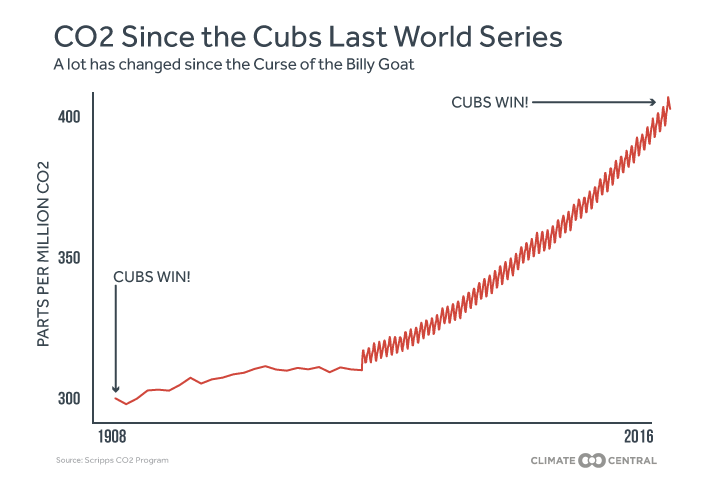Congrats to the Cubs, but is there a correlation between lack of winning and CO2 emissions? Likely not, but you never know!
This is a funny, yet totally not funny graph. It shows that the CO2 concentration in our atmosphere has risen by over 100ppm since the Cubs last won the World Series. “ppm” means “parts per million.” 100 parts per million doesn’t sound like a lot, but CO2 is a powerful greenhouse gas and just a small change has a big impact in our atmosphere.
You can see when Charles Keeling first begin measuring CO2 concentrations precisely (at Mauna Loa observatory in Hawaii) in 1958. At that time, we learned that the Earth “breathes” — that is, it has a regular annual rhythm of CO2 concentration that peaks in April or May and then declines as plants in the Northern Hemisphere soak up CO2 during the growing period in summer. Then, in September we reach the minimum CO2 concentration and plants begin shedding leaves and dying off, releasing CO2 back into the atmosphere. Each year, we reach a new maximum CO2; in 2016, that maximum was about 410ppm, recorded April 9, 2016, and the highest CO2 concentration ever recorded. As I write this, CO2 is about 403ppm and on its way back up to what will be a new record next spring.
It is widely understood by climate scientists that a CO2 concentration over 350ppm is dangerous. We passed that point a long time ago. We need to take immediate and major action to reduce and, ultimately, eliminate all CO2 and other greenhouse gas emissions to avoid catastrophic climate change.


Recent Comments